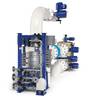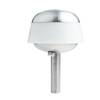The robotic series that remade crusade in skies will shortly extend to a low sea, with underwater view “satellites,” drone-launching pods on a sea building and unmanned ships sport submarines, reports AFP.
The pods could launch surveillance drones in the air or at sea or provide a communications link when American forces are facing electronic jamming, said Jared Adams, spokesman for Defense Advanced Research Projects Agency (DARPA).
Adam said that the proclivity is to capacitate timely deployment of unmanned distributed systems to apart locations by pre-deploying a resources years in allege and afterwards triggering their recover for fast effects during destiny times of a choosing.
DARPA is working on a new system that can be used by the US military, more reliable than GPS. The US government wants a more dependable real-time position tracking technology, seeking something that is unable to be jammed and won't have blind spots.
American researchers are looking during how to emanate and build new weapons quickly, instead of a drawn-out routine that customarily prevails during a Pentagon.
DARPA, famous for breakthrough experiments over a years that helped emanate an Internet, secrecy aircraft, drones, “smart” bombs and micro-technologies, is also penetrating on some other nautical research.
DARPA’s Anti-Submarine Warfare (ASW) Continuous Trail Unmanned Vessel (ACTUV) program seeks to develop a new type of unmanned surface vessel that could independently track adversaries’ ultra-quiet diesel-electric submarines over thousands of miles.
One of the challenges that the ACTUV program is addressing is development of autonomous behaviors for complying with the International Regulations for Preventing Collisions at Sea, known as COLREGS. Substantial progress has been made in developing and implementing those behaviors. Currently, ACTUV’s system for sensing other vessels is based on radar, which provides a “90 percent solution” for detecting other ships.
However, radar is less suitable for classification of the type of other vessels, for example determining whether the vessel is a powered vessel or a sailboat. Additionally, one of the requirements of COLREGS is to maintain “a proper lookout by sight and hearing.”













